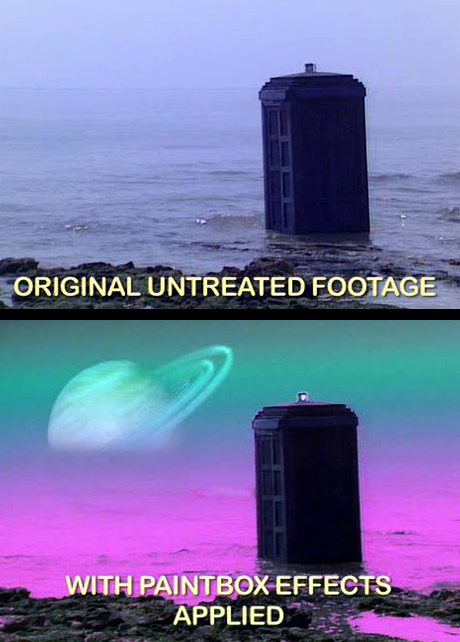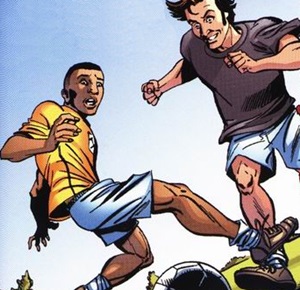Playback was a television production technique in which pre-recorded material was literally played into a scene, rather than being added as a post-production effect. It was universally used in the 1960s as the method by which actors were seen on view screens. As seen in the picture at the left, William Hartnell was pre-recorded separately, then projected live into the scene with the actors in the foreground. Though antiquated, the technique was used even into the 1980s, most notably for the title sequence. The quality of the opening titles for the 1963 version of Doctor Who was never high, because it was never a first-generation copy of the titles. Instead, they were played live into the recording of the first scene of many episodes, causing actors to have to time their first lines to the final notes of the studio-audible Doctor Who theme.
Think Doctor Who is just for boys? Don't you believe it. Not only was the show's very first producer a woman, but it would never have come back without the fierce advocacy of Jane Tranter and Julie Gardner. Considering her importance to Doctor Who it's somewhat ironic that Tranter's only on-screen credits are for Torchwood: Miracle Day. But Gardner, her "partner in crime", is tied only with Russell T Davies as the most prolific producer in Doctor Who history.
The careers of the Fifth, Sixth, Seventh and Eighth Doctors are significantly longer in audio than on television. Check out their latest works at category:2024 audio stories
Officially, only The Lodger has been explicitly adapted from a comic strip — also called The Lodger.
However, several stories have clearly taken material from comic strips — often those in Doctor Who Magazine. The Shakespeare Code contains a good amount of material from A Groatsworth of Wit, and the notion of the Doctor absorbing the time vortex in order to spare a companion was explored in both The Parting of the Ways and The Flood.
Donald Baverstock was the BBC executive who set the the wheels in motion that eventually led to the creation of Doctor Who. Essentially the original commissioner of the programme, he hired Sydney Newman and later imposed a sense of financial responsibility upon producer Verity Lambert.
But Baverstock wasn't the only BBC executive to have a profound impact on the development of Doctor Who. Make sure you read about Lorraine Heggessey, Mark Thompson, Danny Cohen, George Entwistle, Tony Hall, Shaun Sutton, Sydney Newman and others.- 1965 - Part five of the TV Comic story On the Web Planet was first published.
- 1969 - Episode one of The War Games was first broadcast on BBC1.
- 1969 - Part three of the TV Comic story Eskimo Joe was first published.
- 1975 - Part one of Revenge of the Cybermen was first broadcast on BBC1.
- 1975 - Part four of the TV Comic story Return of the Daleks was first published.
- 2002 - Part one of "Death Comes to Time" was first released online.
- 2006 - DWA 2 was first released by BBC Magazines.
- 2007 - Sting of the Zygons, The Last Dodo and Wooden Heart were first published by BBC Books.
- 2008 - Planet of the Ood was first broadcast on BBC One. Later, Oods and Ends aired on BBC Three.
- 2012 - DWA 265 was first released by Immediate Media Company London Limited.
- 2012 - DWMSE 31 was first released by Panini Comics.
- 2017 - Alien Heart and Dalek Soul were first released by Big Finish Productions.
- 2017 - Part two of Sharper Than a Serpent's Tooth was first published in 10DY3 4.
- 2018 - DWMSE 49 was first released by Panini Comics.
- 2018 - DWFC 122 was first released by Eaglemoss Collections.
- 2019 - TCH 19 was first released by Hachette Partworks.
- 2020 - Farewell, Sarah Jane was released on the Doctor Who website.
- 2021 - Series 8 was released in a Steelbook Blu-ray box set.
- ... AUDIO: Legend of the Cybermen was the first appearance of Wendy Padbury and Frazer Hines together in performed Doctor Who since The Five Doctors?
- ... that Barbra Streisand and Donna Summer were both responsible for the song, "Enough Is Enough"? (PROSE: Wetworld)
- ,,, that the date of employment on Rory Williams' ID tag from Royal Leadworth Hospital created a fan controversy upon first transmission of The Eleventh Hour?
- ... that there were two different kinds of abominable snowman controlled by the Great Intelligence? (TV: The Abominable Snowmen, The Web of Fear)
- 1907 - Actor Alan Wheatley was born.[1]
- 1912 - Actor Jack Cunningham was born.[2]
- 1918 - Conductor Marcus Dods was born.[3]
- 1945 - Actor John Abbott was born.[4]
- 1945 - Actor Cleo Sylvestre was born.[5]
- 1960 - Actor Mark Greenstreet was born.[6]
- 1964 - Actor Marcus Harris was born.[7]
- 1972 - Actor Pandora Colin was born.[8]
- 1980 - Actor Tony Beckley died.[9]
- 1983 - Actor Chris Gannon died.[10]
- 1983 - Actor Victoria Yeates was born.[11]
- 1989 - Actor Belinda Owusu was born.[12]
- 1992 - Presenter and Actor Christel Dee was born.[13]
- 2001 - Actor Demi Papaminas was born.[14]
- 2004 - Actor Philip Locke died.[15]
- 2011 - Actor Elisabeth Sladen died.[16]
- 2016 - Actor Graeme Eton died.[17]
- 1968 - Episode three of The Wheel in Space was recorded at BBC Television Centre Studio 1. (TCH 12)
- 1968 - The Mind Robber was extended from four parts into five, with Derrick Sherwin commissioned to write a new opening episode for the story.[18]
- 1971 - Location filming for The Dæmons took place. (REF: Doctor Who The Handbook: The Third Doctor)
- 1980 - Studio filming for The Leisure Hive took place at BBC Television Centre studio 3. (REF: Doctor Who The Handbook: The Fourth Doctor)
- 1989 - Location filming for The Curse of Fenric took place. (Doctor Who The Handbook: The Seventh Doctor)
- 2005 - The Big Finish audio story The Council of Nicaea took place at the Moat Studios.
- 2010 - Big Finish's Bernice Summerfield story Resurrecting the Past was recorded.
- 2010 - The BBC Press Office announced that Katy Manning would return to the role of Jo Grant for a fourth season storyline of The Sarah Jane Adventures, an episode also to feature Matt Smith as the Eleventh Doctor.[19]
- 2018 - Big Finish's audio anthology Class: The Audio Adventures: Volume Two took place at the Moat Studios.
- 2020 - Doctor Who: Lockdown! hosted a tweetatlong of The Stolen Earth/Journey's End in commemoration of the ninth anniversary of Elisabeth Sladen's death.
- 2021 - The Big Finish audio story Watchers was recorded remotely.
- ↑ Find a Grave
- ↑ IMDb
- ↑ Doctor Who Guide
- ↑ Doctor Who Guide
- ↑ Celebrities Galore
- ↑ Doctor Who Guide
- ↑ People Pill
- ↑ People Pill
- ↑ Doctor Who Guide
- ↑ Randall and Hopkirk (Declassified)
- ↑ People Pill
- ↑ Famous Birthdays
- ↑ Doctor Who Guide
- ↑ Doctor Who Guide
- ↑ Famous Birthdays
- ↑ IMDb
- ↑ http://www.shannonsullivan.com/doctorwho/serials/uu.html
- ↑ BBC Press Office - The Doctor and Jo to join CBBC's The Sarah Jane Adventures





